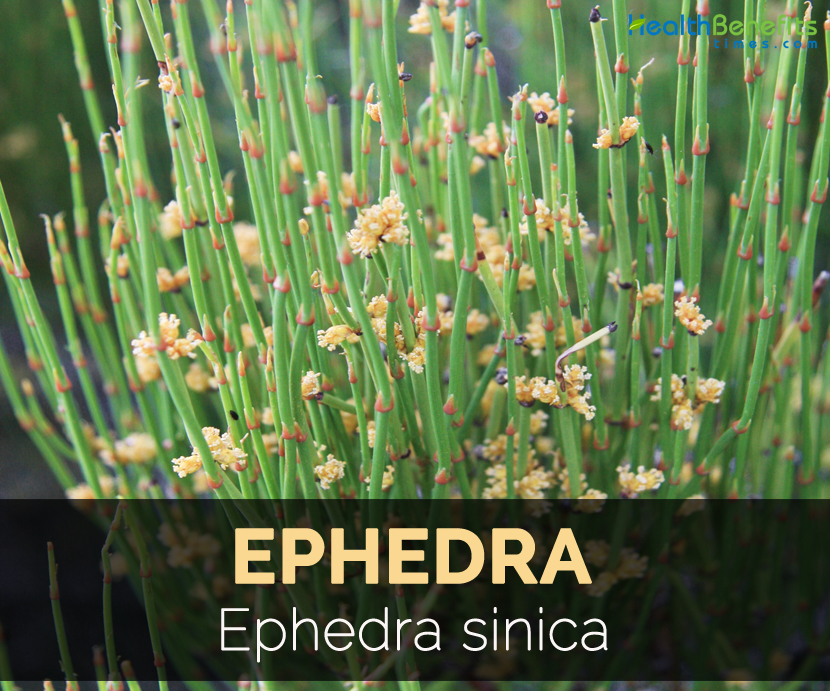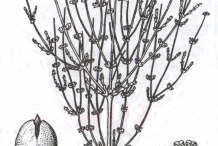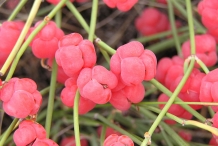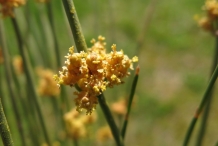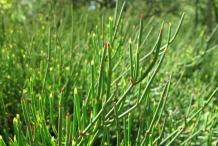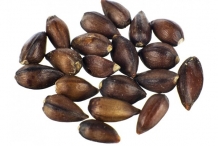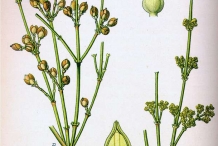History
The use of Ephedra is known since 1st century A.D. In China, it is used as a medicinal herb since thousands of years. About 40 species of Ephedra sinica along with local variants are cultivated in Afghanistan, Australia, Central America, Europe, India, Australia and North America. This plant is used to brew tea and consumed by the people in China due to the presence of stimulating properties. It boost energy, build resistance and treats asthma. In New Mexico, it is used to treat syphilis by Zuni Indians.
Plant
The plant is perennial and evergreen which grows up to 4 foot in height. These are small subshrubs which are sparsely branched with prostate or short woody stems and straight or curved branchlets. It could be found in highlands and arid areas that occurs on dry river beds, slopes, fields, sandy places or mountain sides. The flowering takes place from April to June whereas the fruiting starts from July. The plant bears fleshy, red cones that resembles berries that are poisonous.
Flower
Flowers are small and lowered to pointed scales which are fused at base in pairs. It is dioecious, unisexual and sometimes monoecious. About 2-24 blooms are found in male inflorescences.
Leaves, stem and root
Ephedra plant grows upto 30 cm in height that possess branched subshrub along with cylindrical and lengthened branches which measures about the diameter of 1-2 mm. The branches and stem are round with bright green or gray to green numerous vertical grooves.
Seeds
It has axillary or terminal seed cones which is solitary, 8 × 6-7 mm at maturity and is oblong to ovoid or subglobose in shape. The bracts are in 4 pairs with integument tube of 1-2 mm which is slightly curved or straight. Seeds are black to red or grayish brown which is concealed by equaling bracts. The pollination occurs from May to June.
Health Benefits of Ephedra
Scientifically called Ephedra sinica, it is a plant which has been used for its medicinal purposes for more than 2000 years. Recently, it is used to promote weight loss and bodybuilding community. This herb is brewed as tea and could be found in the form of pill supplements. It has been banned in various countries due to its drug like effects and not allowed to use in professional sports. Though there are many controversies regarding Ephedra, small doses of it acts as an aid for various disorders and health problems. Some are discussed below in detail:
- Treatment for obesity
Obesity is a contributor of both metabolic syndrome and glucose intolerance. The study has investigated about anti-hyperglycemic and anti-obesity activities of Ephedra sinica tested on high fat diet fed to mice. Ephedra lower gain in weight and accumulation of epididymal fat, lower triglycerides and improve glucose intolerance. Furthermore, it improves HDL cholesterol level, glucose levels and lowers the chances of weight gain. (1)
- Metabolic disorder
The change in gut microbiota is related with obesity, metabolic syndrome and type 2 diabetes. Ephedra possess anti-obesity properties that are helpful for metabolic disorders. The treatment done with Ephedra sinica reduce the level of serum insulin, blood glucose and insulin resistance index. Transplantation of Esm preserves the efficacy of amelioration on metabolic disorders and HFD induced obesity associated with enterogeous endotoxin, intestinal microbiota and enteral acetic acid. (2)
- Promote energy
Ephedra is used for boosting energy due to the presence of active compound named ephedrine that promotes the flow of blood and stimulate heart that helps to energize body and assist in flow of oxygen and blood to the muscles. Despite it could be harmful, as it put strain on heart, for those who has existing heart problems.
- Assist to lose weight
Ephedra has gained a huge popularity for its weight loss. It is a unique alternative for those people who wants to lose weight fast but is not particularly active. It burns fat by stimulating metabolism. It is used without any physical component by some people that additionally pressurize the body’s system.
- Lowers fatigue
The supplement of Ephedra might be helpful for those with insomnia or chronic fatigue. It increases the level of energy and keeps us active. It should strictly be used in small amount.
- Assist cognition
Some studies have shown that Ephedra is able to increase cognition as it enhance the flow of blood to brain as well as other vital organs and upgrades neural processing. It should be used in balance and should not be used regularly.
- Enhance immune system
Ephedra has steroidal properties that boost immune system which counteracts with flu and common cold effectively. It should not be used as preventative medicine. Some studies have shown that the use of Ephedra on the onset stage of illness helps the one to speed up the healing process and prevents full blown sickness.
- Respiratory conditions
Ephedra assist in lowering inflammation caused on mucous membranes such as respiratory tract. This helps to prevent wheezing and asthmatic attacks. It clears the passage and allows air to lungs which could prevent the chances of common respiratory problems.
- Normalize blood pressure
The people with hypotension are concerned for lowering their blood pressure. The addition of Ephedra to the regime supports the blood pressure and heart health. Consult the health practitioner before using this as a herbal remedy.
Traditional uses
- Traditionally, it is used to treat hayfever, asthma, colds, coughs, urticarial, fever, narcolepsy, enuresis, chronic postural hypotension, myasthenia gravis and rheumatism.
- It possesses bronchodilating, vasoconstricting and central stimulating activities.
- Ephedra is useful for nasal congestion caused due to allergic rhinitis, hayfever, sinusitis and common cold.
- It suppresses appetite.
- It is used to treat respiratory diseases.
- It is useful for severe febrile illnesses, joint symptoms, bronchial asthma, coughing with dyspnea, inability to perspire, pains in the bones and edema.
- Boil one teaspoon of Ephedra sinica in ¼ liter of water for about 5 to 10 minutes and used it for treating asthma, bronchitis, hay fever and respiratory problems.
- It is used to promote menstruation and uterine contractions.
- As it possesses antispasmodic properties, it clears air passages.
- It acts as a performance booster and also increases circulation of blood to muscles.
- It provides a tightening effect on the blood vessels near the skin’s surface and also enlarges small airways in the bronchioles of lungs.
Precautions or Disadvantages
- Anxiety, insomnia, restlessness and tachycardia are the common side effects caused by Ephedra.
- It also causes dry mouth, tremor, cardiac arrhythmias, hypertension and impaired circulation to extremities, urinary retention and skin rashes.
- In case of tremor, loss of appetite, nervousness and nausea with the use of ephedra, lower the dose or discontinue using.
- It is better to be avoided by the lactation, pregnant women, children and aged people due to the absence of reliable data on its use.
- Side effects such as irritability, sleeplessness, headache, nausea, motor restlessness, vomiting, hyperthermia, increased blood pressure, urinary disorders and tachycardia.
- Excessive use of Ephedra causes cardiac rhythm disorders and blood disorder.
- It could lead to life threatening poisonings which might show the symptoms such as spasms, sweating, enlarged pupils and elevated body temperature.
- It might cause strokes, heart attacks or even death.
- Use it only under the supervision of medical practitioner.
- The people with health problems of high blood pressure, depression, anxiety, glaucoma, high blood pressure, prostate enlargement, heart disease, seizure disorder, urination difficulty, psychiatric disorders, impaired circulation to brain, diabetes or thyroid disorders should not use it.
- It may worsen the existing kidney disease and heart disease.
- It increases the level of blood sugar.
- It intensifies seizures in the people having seizure disorders.
- Do not use with other medicine or dietary supplements.
- With caffeine, it increases the chances of serious side effects.
- Avoid with the use of food products such as chocolate, cola, tea, gotu kola, caffeine, cold or decongestant medications, guarana, phenylephrine or amphetamines and weight loss medications.
How to Eat
- Dried or fresh Ephedra sinica are added to brandy or wine. Add fennel, anise and cardamom to reduce its bitter taste.
- It is used in form of drink as a substitute for coffee and black tea.
Other Facts
- It is a perennial plant which could survive for more than two years in wild.
- It is used for manufacturing illegal and street drugs named methamphetamines.
- It produces seed bearing cones and small or yellowish pollen bearing cones.
- Cones are for pollination by wind which could be seen from May to June.
- The propagation is done by division of root or seed.
- Ephedra could assist in the prevention of soil erosion due to the presence of its strong root system.
- It is used to provide calming effect by Zen monks at the time of meditation.
References:
https://www.itis.gov/servlet/SingleRpt/SingleRpt?search_topic=TSN&search_value=505858#null
http://davesgarden.com/guides/pf/go/95947/
http://pfaf.org/User/Plant.aspx?LatinName=Ephedra+sinica
https://www.mskcc.org/cancer-care/integrative-medicine/herbs/ephedra
http://www.umm.edu/health/medical/altmed/herb/ephedra
http://www.encyclopedia.com/medicine/drugs/pharmacology/ephedra
http://www.innovateus.net/innopedia/what-herb-ephedra-sinica-ma-huang
https://nccih.nih.gov/health/ephedra
http://www.softschools.com/facts/plants/ephedra_facts/1568/
https://www.organicfacts.net/ephedra.html
https://www.herbal-supplement-resource.com/ephedra-ma-huang.html
Comments
| Ephedra Quick Facts | |
|---|---|
| Name: | Ephedra |
| Scientific Name: | Ephedra sinica |
| Origin | This plant is native of Russia, Mongolia and Northeastern China. |
| Health benefits | Treatment for obesity, Metabolic disorder, Promote energy, Assist to lose weight, Lowers fatigue |
| Name | Ephedra |
|---|---|
| Scientific Name | Ephedra sinica |
| Native | It is widely distributed to Mongolia, Southern Siberia and China. This plant is native of Russia, Mongolia and Northeastern China. |
| Common/English Name | Chinese ephedra, Ma Huang, herbal ecstasy, teamster’s tea, desert tea, sea ephedrine, yellow astringent, yellow horse, squaw tea, joint fir, popotillo, mormon tea, sea grape |
| Name in Other Languages | English: Chinese Ephedra, Chinese Joint-Fir; Swedish: Kinesisk Efedra; Chinese: Huá máhuáng (华麻黄), Cǎo máhuáng (草麻黄), 麻黄 (麻黄); Finnish: Kiinanefedra; |
| Plant Growth Habit | Subshrubs |
| Plant Size | 12-18 in. (30-45 cm) |
| Branchlets | Straight or curved |
| Leaf | Opposite, subulate to narrowly triangular, 5 mm |
| Flower | Small, unisexual, dioecious |
| Plant parts used | Aerial parts |
| Seed | Black to red or grayish brown |


